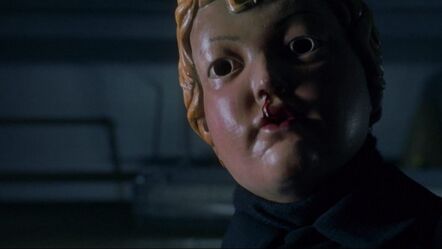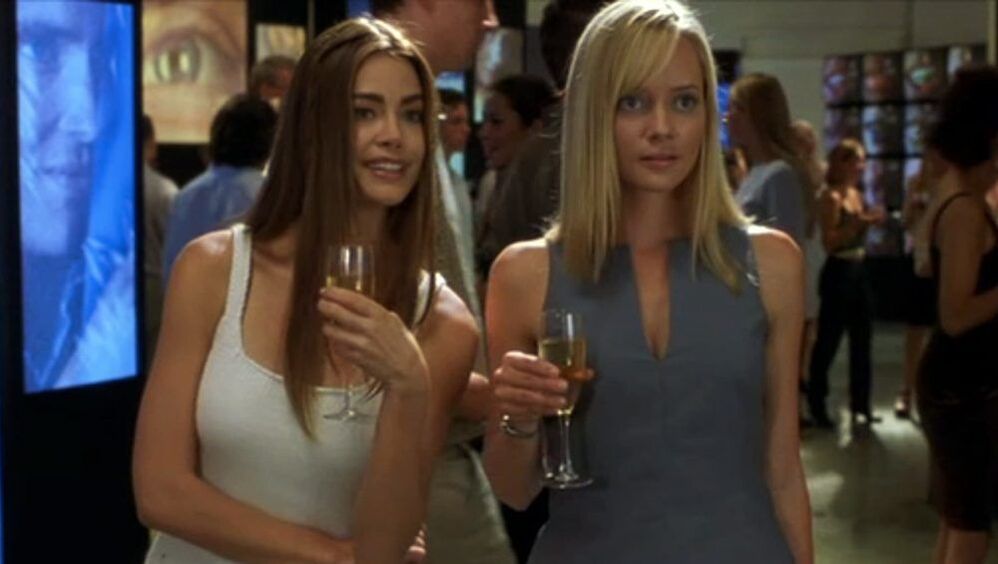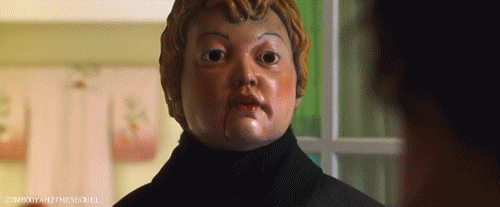 In recent years, the film community has embraced February as Women in Horror Month (though that is now changing)... ...It’s fitting, then, that this year is also the 20th anniversary of 2001’s Valentine (which releases February 2nd, 2001). The holiday-themed horror stands out from typical slasher fare of its era by subverting some of the genre’s most standard tropes. The film is centered on a group of four best girlfriends who have known each other since grade school. We’re introduced to them at a 6th grade school party where the unpopular, gawky Jeremy Melton (Joel Palmer) has asked each girl for a dance. Rejected by everyone, he asks fellow outcast Dorothy (played in younger years by Kate Logie), who accepts. When they’re caught kissing, she turns on him and he’s mercilessly bullied and tormented by the other kids. Fast forward about a decade; the women are now grown, and still close friends. But when they begin receiving disturbing Valentine’s Day cards from “Jeremy Melton” they question which men from their past could be taunting them. On the surface, Valentine is a clichéd slasher where women repeatedly put themselves in situations that get them killed. And while this is true through the movie’s ninety-six-minute run, under the surface there are some noticeable differences. The clearest of these is the cast of predominantly strong women who command the screen. The friends fit into their appropriate trope boxes, but it also feels like Valentine is in on the joke. Dorothy at one point describes them as: Kate, (Marley Shelton) the popular one, Lily, (Jessica Cauffiel) the fun one, Paige, (Denise Richards) the sexy one, and labels herself the fat one. There’s also Shelley, played by Katherine Heigl in a Drew Barrymore-in-Scream style cameo. The men of Valentine, on the other hand, have little participation. There only to portray con artists, alcoholics, philandering boyfriends, and sleazy cops, it feels as though it aims to make an example of its male characters, even as it kills off most of its female cast. Most men here are expendable, and maybe even deserving of their fates. Within five minutes of the film, we meet the first of Valentine’s men, Jason Marquette (Adam Harrington). He’s Shelley’s first date, whom she’s dining with at a restaurant. He talks about himself in the third person, splits the check, and says stuff like, “this hard-to-get shit doesn’t play.” The speed-dating scene shortly after gives us a quick array of awful men in the span of several minutes. The only one who momentarily appears charming will also soon turn out to be a presumptuous, disrespectful jerk. There’s Lily’s guy, Max (Johnny Whitworth), who initiates threesomes without her consent; Dorothy’s would-be boyfriend Campbell (Daniel Cosgrove), a handsome grifter who preys on rich women; Paige’s suitor from the speed-dating scene who drops his pants and tells her to ‘wax it’ within seconds of meeting up; a sleazy police detective; and Kate’s creepy neighbor who tries on her underwear when she’s not home. In fact, there’s not one man in Valentine with a redeeming quality. Except possibly Adam (David Boreanaz), Kate’s boyfriend. A struggling alcoholic, he seems to have a heart and conscience. Valentine shows its age at times. From the outfits, to Lily’s use of a video dating service, to the almost non-existent use of Internet research that in today's horror would be a montage where important exposition details are uncovered. The killer's cherub mask, though cliché, somehow feels fresh and scary and works to further drill in the Valentine's Day theme. It even feels similar to the Babyface mask used in Happy Death Day. There are references to timely pop culture; more proof that Valentine is self-aware. At one point while defending Adam, Kate says, "He's no angel, but he's not a killer." Clearly an Easter egg referencing David Boreanaz's Buffy the Vampire Slayer character. Despite its similarities to many slashers, Valentine gives its female characters a noticeable power, one usually only relegated to the final girl or main protagonist. They’re strong women who question the motives of men, don’t take crap, and won’t stand for any mistreatment. Except for Dorothy (Jessica Capshaw), who still suffers from extremely low self-esteem and insecurities stemming from childhood. She's wealthy but has a father more interested in his young bride than his daughter. As a result, Dorothy is bitter and resentful towards her friends. Her tragic backstory makes her the perfect red herring. Generally, horror from the 2000's doesn’t have much depth. House of Wax, Wrong Turn, and Sorority Row, while all fun, don't spend time diving into anything deeper than the use of a sharp blade. But here, topics like bullying are important themes. They serve as warnings that they can have devastating, long-term consequences to those who suffered. Adam expresses this idea to Kate at the end, telling her, "Someone is that lonely, that angry, they learn to hide it...but it eats away at you, until one day, you have to do something about it." Dorothy and Jeremy Melton’s suffering are intertwined to show the universality of the feeling; it spans beyond the obvious outcast or antagonist. Perhaps some of these layers are due to the fact the film is adapted from a book. Tom Savage's 1996 thriller Valentine is the inspiration, though it differs in many ways. For one, the women are older and, rather than have them as strong focal points, the novel gives most of its attention to the killer, who’s darker P.O.V. is central to the story. A sinister stalker angle certainly would've been interesting to explore in the film. But even with certain distinguishable traits, there are formulas horror from this era must follow. Lastly, an untidy ending allows Valentine to stand out among its counterparts. Similar movies end with an epic showdown between villain and hero. But this 2001 slasher purposely lacks a completely satisfying conclusion. Instead, it opts for an open ended (though obvious) twist which provides little closure. This difference makes Valentine unique as both smarter and more memorable, even twenty years later. By Blake Turck Please consider joining us in celebrating Black History Month by donating to BlackLivesMatter.com
3 Comments
ERIC
2/13/2023 01:33:32 pm
MELODY THOMAS SCOTT THE YOUNG AND THE RESTLESS FAVOURITE SHOW SUPERNANNY
Reply
ERIC
3/28/2023 10:35:31 pm
MELODY THOMAS SCOTT FROM THE YOUNG AND THE RESTLESS FAVOURITE SHOW SUPERNANNY
Reply
ERIC
3/28/2023 10:36:36 pm
MELODY THOMAS SCOTT FROM THE YOUNG AND THE RESTLESS FAVOURITE SHOW SUPERNANNY
Reply
Leave a Reply. |
Archives
March 2023
|


 RSS Feed
RSS Feed